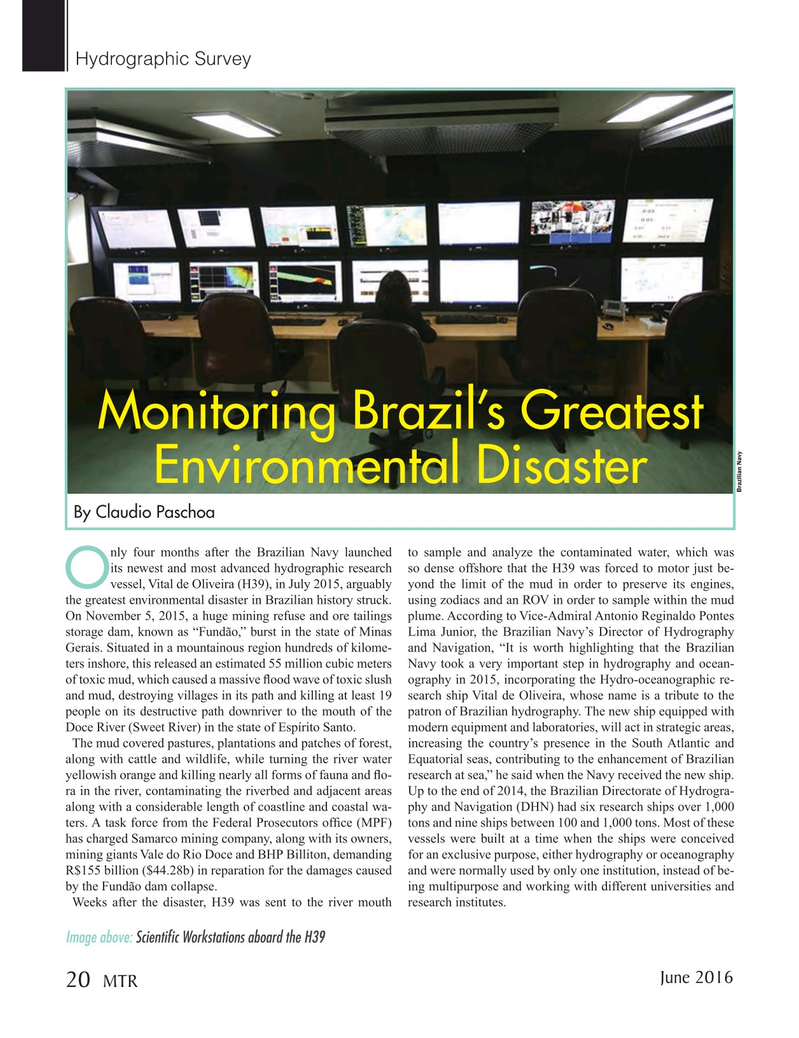
Page 20: of Marine Technology Magazine (June 2016)
Hydrographic Survey
Read this page in Pdf, Flash or Html5 edition of June 2016 Marine Technology Magazine
Hydrographic Survey
Monitoring Brazil’s Greatest
Environmental Disaster
Brazilian Navy
By Claudio Paschoa nly four months after the Brazilian Navy launched to sample and analyze the contaminated water, which was its newest and most advanced hydrographic research so dense offshore that the H39 was forced to motor just be-
Ovessel, Vital de Oliveira (H39), in July 2015, arguably yond the limit of the mud in order to preserve its engines, the greatest environmental disaster in Brazilian history struck. using zodiacs and an ROV in order to sample within the mud
On November 5, 2015, a huge mining refuse and ore tailings plume. According to Vice-Admiral Antonio Reginaldo Pontes storage dam, known as “Fundão,” burst in the state of Minas Lima Junior, the Brazilian Navy’s Director of Hydrography
Gerais. Situated in a mountainous region hundreds of kilome- and Navigation, “It is worth highlighting that the Brazilian ters inshore, this released an estimated 55 million cubic meters Navy took a very important step in hydrography and ocean- of toxic mud, which caused a massive ? ood wave of toxic slush ography in 2015, incorporating the Hydro-oceanographic re- and mud, destroying villages in its path and killing at least 19 search ship Vital de Oliveira, whose name is a tribute to the people on its destructive path downriver to the mouth of the patron of Brazilian hydrography. The new ship equipped with
Doce River (Sweet River) in the state of Espírito Santo. modern equipment and laboratories, will act in strategic areas,
The mud covered pastures, plantations and patches of forest, increasing the country’s presence in the South Atlantic and along with cattle and wildlife, while turning the river water Equatorial seas, contributing to the enhancement of Brazilian yellowish orange and killing nearly all forms of fauna and ? o- research at sea,” he said when the Navy received the new ship. ra in the river, contaminating the riverbed and adjacent areas Up to the end of 2014, the Brazilian Directorate of Hydrogra- along with a considerable length of coastline and coastal wa- phy and Navigation (DHN) had six research ships over 1,000 ters. A task force from the Federal Prosecutors of? ce (MPF) tons and nine ships between 100 and 1,000 tons. Most of these has charged Samarco mining company, along with its owners, vessels were built at a time when the ships were conceived mining giants Vale do Rio Doce and BHP Billiton, demanding for an exclusive purpose, either hydrography or oceanography
R$155 billion ($44.28b) in reparation for the damages caused and were normally used by only one institution, instead of be- by the Fundão dam collapse. ing multipurpose and working with different universities and
Weeks after the disaster, H39 was sent to the river mouth research institutes.
Image above: Scienti? c Workstations aboard the H39
June 2016 20 MTR
MTR #5 (18-33).indd 20 6/1/2016 5:16:06 PM

 19
19

 21
21
